Prevalence, genetic diversity, and zoonotic potential of Giardia duodenalis in New and Old World Camelids: A comparative systematic review and meta-analysis
IF 2
3区 农林科学
Q4 IMMUNOLOGY
Comparative Immunology Microbiology and Infectious Diseases
Pub Date : 2025-02-06
DOI:10.1016/j.cimid.2025.102316
引用次数: 0
Abstract
This study aimed to review and analyze the prevalence, genetic diversity, and zoonotic potential of Giardia duodenalis in New World Camelids (NWCs) and Old World Camelids (OWCs), highlighting geographic and host-related variations. The statistical analyses were conducted using CMA software to estimate pooled prevalence rates. Heterogeneity was evaluated with the I² statistic, and sensitivity analysis tested pooled prevalence after removing certain studies. Meta-regression examined the association between G. duodenalis prevalence in camelids and factors like publication year and sample size. Subgroup analyses investigated prevalence variations based on countries, continents, WHO regions, publication years, diagnostic methods, and sample sizes. A total of 22 studies/23 datasets were included, with eight on NWCs and 15 on OWCs, covering 5008 camelids across nine countries. The weighted G. duodenalis prevalence in camelids was 8.7 % (95 % CI: 5.6–13.3), with NWCs at 10.3 % (95 % CI: 3–29.7) and OWCs at 9.1 % (95 % CI: 6.7–12.2). Geographical analyses revealed the highest prevalence of G. duodenalis in South America (40.4 %) and the AMR WHO region (10.8 %), with notable rates in Peru (40.4 %) and Iraq (11.9 %). Sensitivity analysis showed that prevalence rates remain robust, unaffected by study exclusions. Neither the year of study nor sample size influenced infection rates in camelids. The identification of zoonotic assemblages A and E, and zoonotic sub-assemblage AI in camelids, is of public health significance. These insights enhance our understanding of G. duodenalis epidemiology in camelids, underscoring the need for ongoing surveillance and research regarding their effects on human and animal health.
贾第鞭毛虫在新旧世界骆驼中的流行、遗传多样性和人畜共患潜力:一项比较系统回顾和荟萃分析
本研究旨在回顾和分析贾第虫在新世界和旧世界Camelids (NWCs)中的流行情况、遗传多样性和人畜共患的可能性,重点介绍地理和宿主相关的差异。使用CMA软件进行统计分析,以估计合并患病率。采用I²统计量评估异质性,并在剔除某些研究后进行敏感性分析。荟萃回归检验了十二指肠十二指肠杆菌在骆驼科动物中的流行与出版年份和样本量等因素之间的关系。亚组分析调查了基于国家、大洲、世卫组织区域、出版年份、诊断方法和样本量的患病率差异。共纳入22项研究/23个数据集,其中8项关于NWCs, 15项关于OWCs,涵盖9个国家的5008只骆驼。十二指肠棘球蚴在骆驼群中的加权患病率为8.7 %(95 % CI: 5.6-13.3), nwc为10.3 %(95 % CI: 3-29.7), OWCs为9.1 %(95 % CI: 6.7-12.2)。地理分析显示,南美洲和AMR - WHO区域十二指肠十二指肠螺杆菌患病率最高,分别为40.4% %和10.8% %,秘鲁(40.4% %)和伊拉克(11.9% %)的患病率最高。敏感性分析显示,患病率保持稳定,不受研究排除的影响。研究年份和样本量对骆驼的感染率都没有影响。鉴定骆驼人畜共患病组合A和E以及人畜共患病亚组合AI具有重要的公共卫生意义。这些见解增强了我们对骆驼中十二指肠梭菌流行病学的理解,强调了对其对人类和动物健康的影响进行持续监测和研究的必要性。
本文章由计算机程序翻译,如有差异,请以英文原文为准。
求助全文
约1分钟内获得全文
求助全文
来源期刊
CiteScore
4.60
自引率
0.00%
发文量
102
审稿时长
40 days
期刊介绍:
Comparative Immunology, Microbiology & Infectious Diseases aims to respond to the concept of "One Medicine" and to provide a venue for scientific exchange. Based on the concept of "Comparative Medicine" interdisciplinary cooperation between specialists in human and animal medicine is of mutual interest and benefit. Therefore, there is need to combine the respective interest of physicians, veterinarians and other health professionals for comparative studies relevant to either human or animal medicine .
The journal is open to subjects of common interest related to the immunology, immunopathology, microbiology, parasitology and epidemiology of human and animal infectious diseases, especially zoonotic infections, and animal models of human infectious diseases. The role of environmental factors in disease emergence is emphasized. CIMID is mainly focusing on applied veterinary and human medicine rather than on fundamental experimental research.

 求助内容:
求助内容: 应助结果提醒方式:
应助结果提醒方式:


